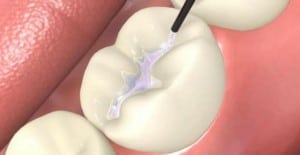 A sealant is a flowable plastic that is applied to the chewing surfaces of teeth. The anatomy of back teeth consists of several depressions and grooves, which are very prone to trapping food debris and bacteria. The majority of tooth decay occurs in these hard-to-clean grooves.
A sealant is a flowable plastic that is applied to the chewing surfaces of teeth. The anatomy of back teeth consists of several depressions and grooves, which are very prone to trapping food debris and bacteria. The majority of tooth decay occurs in these hard-to-clean grooves.
The sealants are applied in our Apopka dental office and primarily applied to children and teenagers’ teeth. It is critical to apply sealants as soon as the back permanent teeth become fully erupted. They are applied to teeth that show no signs of decay or significant staining. It is not ideal to seal over a questionable site on a tooth or over decay, because a cavity may continue to grow underneath it. Adults can benefit from sealant too, as long as the decay process has not started on the tooth.
Prevention is always better than treatment. When applied correctly, sealants are extremely effective in preventing tooth decay and the accumulation of plaque and bacteria.
How long does a sealant last?
Sealants hold up well under the forces of normal chewing. As long as the plastic resin remains intact, in the grooves of the teeth, the chewing surface is protected from decay. Sealants typically last several years before reapplication is necessary. However, if the patient chews regularly on ice, hard candies, etc., parts of the sealant may chip or break, leading to more frequent replacement.
How are sealants applied?
Applying a sealant to the teeth is painless and rarely involves drilling or anesthesia. It only takes a few minutes to apply the plastic coating to each tooth.
The teeth are cleaned and the chewing surfaces are conditioned to help the sealant adhere to the tooth. The sealant is literally painted onto the necessary surfaces, where it flows into the pits and fissures. It bonds to the tooth and the hardening process is accelerated with a specialized blue light.
